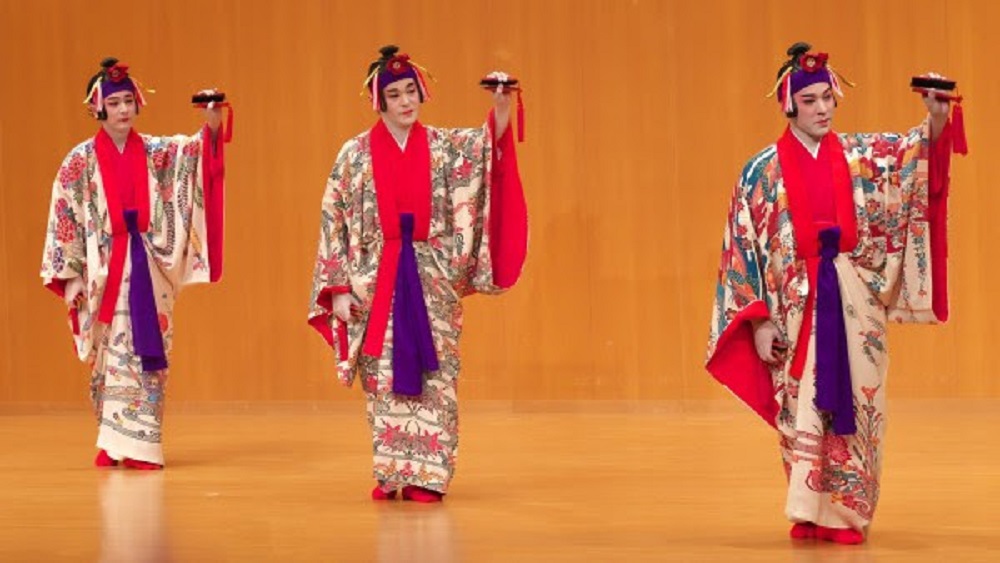
Japan Society Presents Waves Across Time, Traditional Dance and Music of Okinawa
Japan Society’s Waves Across Time: Traditional Dance and Music of Okinawa marks the 50th anniversary of the return of Okinawa to Japan following the U.S.’s post-WWII occupation. A group of the islands’ most exquisite dancers will perform a diverse program of Okinawan traditional performing arts accompanied by live music.
Presented live and in-person at Japan Society, 333 East 47 Street, Waves Across Time: Traditional Dance and Music of Okinawa will have two NYC performances, on Friday March 18 and Saturday March 19 at 7:30pm on both evenings. A pre-performance lecture, available to all ticket holders, will start at 6:30pm before each performance and will introduce Okinawa’s history and the development of its unique dance forms and musical instruments.
In this program, versatile artists selected by the award-winning young artistic director of the National Theatre Okinawa, Michihiko Kakazu, will perform highlights chosen by Kakazu from the traditional repertoires of kumiodori and zo odori. This program reflects Okinawa’s complex history and rich performing arts heritage.
Kumiodori, a form of noh-inspired theater developed when the island archipelago of Okinawa was an independent kingdom called Ryukyu, was designated an Intangible Cultural Asset by UNESCO in 2010. The classical dance and music repertoire from the Ryukyu Kingdom, performed in bright, gorgeous costumes, is elegant and deliberate with dignified melodies and rhythmic accompaniment.
Zo odori are popular folk dances that originated in 19th century, as the Ryukyu Kingdom was dissolved and the royal courts disbanded. These energetic and dynamic folk dances, often performed barefoot in a simple kimono made of indigo-dyed fabric or abaca cloth, feature the cheerful rhythms of typical Okinawan music.
The first half of this live program begins with two independent dance pieces developed from excerpts of the classical kumiodori titled “Manzai Techiuchi.” The first excerpt, “Sakamoto-bushi,” is a female duo dance performed with Okinawan castanets called yotsudake. The second piece is a dance between two young brothers disguised as street performers as a ploy to avenge their parents. This section concludes with an excerpt from “Timiji-no-en,” a romantic masterpiece from the kumiodori repertoire, featuring a popular scene called “Shinobi no ba” (or, “A Scene of Secrecy”), depicting the secret rendezvous of two star-crossed lovers. This scene includes several well-known classical Ryukyuan ensemble pieces, as well as solo instrumental pieces for the koto and fue (flute).
The second half of the program features a variety of zo odori pieces, including a female dance that expresses the joy of a journey; a duet between a male and female dancer about life in a fishing village; and a dance that employs karate and weaponry such as sai and nunchaku; and a love duet. The program culminates with a narrative medley from the zo odori repertoire, representing farmers and fishermen gathered together to embrace their village life.
Throughout the performance, an ensemble of musicians will accompany this stunning array of works on the sanshin — a snakeskin-covered banjo-like instrument unique to the islands, as well as other traditional instruments. The brightly-dyed bingata costumes and the island music’s iconic use of pentatonic scales further immerse audiences in the traditional performing styles of Japan’s southernmost prefecture.
General Entry Tickets to Japan Society’s Waves Across Time are $42 or $32 for Japan Society members. Tickets can be purchased online at japansociety.org or by phone at the Box Office, Monday through Friday between 9am and 5pm at 212-715-1258.
